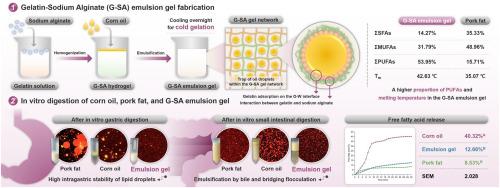Constructing stable emulsion gel from gelatin and sodium alginate as pork fat substitute: Emphasis on lipid digestion in vitro
IF 11
1区 农林科学
Q1 CHEMISTRY, APPLIED
引用次数: 0
Abstract
This study aimed to develop a gelatin-sodium alginate (G-SA) emulsion gel that can efficiently hold corn oil, as a substitute for pork fat while controlling the digestive behaviors of lipids in vitro. UV, fluorescence, and circular dichroism spectra and surface hydrophobicity measurements of the G-SA mixtures indicated that gelatin and sodium alginate primarily form aggregates through hydrogen bonds and hydrophobic interactions, and the optimum gelatin-to-sodium alginate w/w ratio was identified as 1.9. The final emulsion gel contained 3.15% gelatin and 1.65% sodium alginate (w/w) with a corn oil content of 40% (w/w). G-SA emulsion gel had a higher proportion of polyunsaturated fatty acids (PUFAs, 53.95 g/100 g) than pork fat (15.17 g/100 g). In addition, the G-SA emulsion gel exhibited stable viscoelastic properties without storage and loss moduli changes at increasing shear rates. The G-SA emulsion gel had a higher melting temperature (42.63 °C) than pork fat (35.07 °C). In vitro digestion studies showed that corn oil had a higher free fatty acid release (40.32%) compared to the G-SA emulsion gel (12.66%) and pork fat (8.53%) (P<0.05), indicating that the digestibility of corn oil was reduced in the G-SA emulsion gel. Calcein release experiments revealed that G-SA emulsion gel released the least amount of calcein (P<0.05) during digestion at a slow rate. The G-SA emulsion gel, similar to pork fat, contained evenly distributed digestive particles encapsulating corn oil after in vitro gastric digestion, with the smallest particle size among the treatments. After the in vitro small intestinal digestion phase, the G-SA emulsion gel maintained small droplet sizes with bridging flocculation. The in vitro digesta of the G-SA emulsion gel contained a significantly higher proportion of PUFAs compared to pork fat (P<0.05). Consequently, the G-SA emulsion gel can be a potential substitute for pork fat, offering higher proportions of PUFAs, lower fat content, and controlled lipid digestion with reduced lipid digestibility.

用明胶和海藻酸钠构建稳定的乳液凝胶,作为猪肉脂肪替代品:强调体外脂质消化
本研究旨在开发一种明胶-海藻酸钠(G-SA)乳液凝胶,它可以有效地保持玉米油,作为猪肉脂肪的替代品,同时控制脂类在体外的消化行为。G-SA 混合物的紫外光谱、荧光光谱、圆二色光谱和表面疏水性测量结果表明,明胶和海藻酸钠主要通过氢键和疏水作用形成聚集体,明胶与海藻酸钠的最佳重量比为 1.9。最终的乳液凝胶含有 3.15%的明胶和 1.65%的海藻酸钠(重量比),玉米油含量为 40%(重量比)。与猪肉脂肪(15.17 克/100 克)相比,G-SA 乳液凝胶的多不饱和脂肪酸(PUFA,53.95 克/100 克)比例更高。此外,G-SA 乳液凝胶表现出稳定的粘弹性能,在剪切速率增加时不会发生储存和损失模量的变化。G-SA 乳液凝胶的熔化温度(42.63 °C)高于猪脂肪(35.07 °C)。体外消化研究表明,玉米油的游离脂肪酸释放率(40.32%)高于 G-SA 乳液凝胶(12.66%)和猪脂肪(8.53%)(P<0.05),这表明玉米油在 G-SA 乳液凝胶中的消化率降低了。钙黄绿素释放实验表明,G-SA乳液凝胶在消化过程中释放的钙黄绿素最少(P<0.05),且释放速度较慢。体外胃消化后,G-SA 乳化凝胶与猪脂肪相似,含有均匀分布的包裹玉米油的消化颗粒,其粒径在各处理中最小。在体外小肠消化阶段后,G-SA 乳液凝胶保持了小液滴的尺寸,并有架桥絮凝现象。与猪肉脂肪相比,G-SA乳液凝胶的体外消化物所含的超不饱和脂肪酸比例明显更高(P<0.05)。因此,G-SA 乳液凝胶可作为猪脂肪的潜在替代品,提供更高的 PUFAs 比例、更低的脂肪含量、可控的脂质消化率以及更低的脂质消化率。
本文章由计算机程序翻译,如有差异,请以英文原文为准。
求助全文
约1分钟内获得全文
求助全文
来源期刊

Food Hydrocolloids
工程技术-食品科技
CiteScore
19.90
自引率
14.00%
发文量
871
审稿时长
37 days
期刊介绍:
Food Hydrocolloids publishes original and innovative research focused on the characterization, functional properties, and applications of hydrocolloid materials used in food products. These hydrocolloids, defined as polysaccharides and proteins of commercial importance, are added to control aspects such as texture, stability, rheology, and sensory properties. The research's primary emphasis should be on the hydrocolloids themselves, with thorough descriptions of their source, nature, and physicochemical characteristics. Manuscripts are expected to clearly outline specific aims and objectives, include a fundamental discussion of research findings at the molecular level, and address the significance of the results. Studies on hydrocolloids in complex formulations should concentrate on their overall properties and mechanisms of action, while simple formulation development studies may not be considered for publication.
The main areas of interest are:
-Chemical and physicochemical characterisation
Thermal properties including glass transitions and conformational changes-
Rheological properties including viscosity, viscoelastic properties and gelation behaviour-
The influence on organoleptic properties-
Interfacial properties including stabilisation of dispersions, emulsions and foams-
Film forming properties with application to edible films and active packaging-
Encapsulation and controlled release of active compounds-
The influence on health including their role as dietary fibre-
Manipulation of hydrocolloid structure and functionality through chemical, biochemical and physical processes-
New hydrocolloids and hydrocolloid sources of commercial potential.
The Journal also publishes Review articles that provide an overview of the latest developments in topics of specific interest to researchers in this field of activity.
 求助内容:
求助内容: 应助结果提醒方式:
应助结果提醒方式:


